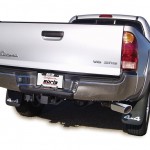Contents
For 4 decades, Mitsubishi’s full-sized Pajero was the brand’s heavyweight SUV flagship, known for its reliability and comfort. Over 150k units were sold in Australia during its 40-year run, and the intercooled, fourth-generation 3.2L turbodiesel NSs and NTs are arguably considered its most popular models. But even though their distinctively spacious styling offers plenty of head and leg space, they’ve always been short in the tooth when it comes to power.
The Pajero’s 125kW / 358Nm output may be among the most consistent of all Aussie SUVs, but it certainly doesn’t rank it among the highest. Not surprisingly, there’s one equally consistent approach that can be taken to unleash more of the power that these rock-stable 4-cylinders are capable of producing: it’s as simple as mounting an aftermarket exhaust system.
Torquey Exhaust Upgrades For Your Gen 4 Pajero

If you’re like most Pajero owners, you’re probably a little skeptical about just how much more power you can actually get from a new exhaust. Make no mistake, though: upgraded, low-restriction Mitsubishi Pajero exhausts are genuine performance game-changers. Without any other modifications, simply increasing the Pajero’s exhaust tube diameter from 2.5“ to 3.0“ will instantly yield an extra 5 -15kW, and that’s only the beginning.
What’s important to consider about aftermarket Pajero exhaust systems is that they aren’t as much power producers as they are power optimizers. The Pajero’s noticeably restrictive exhaust system is great at reducing emissions, but it does so at the expense of low-end power and fuel economy. An upgraded 3.0“ Pajero exhaust, however, is designed to let your engine breathe better as well as run cooler – characteristics that offer a bevy of benefits that include:
- Better exhaust flow/scavenging. Upgraded Pajero exhausts allow spent gases to move easily from high to low pressure, thereby improving evacuation.
- Greater exhaust velocity. With the improved scavenging that comes from better flow, gases don’t just move easier through the system, they also move quicker, which ultimately multiplies the scavenging benefit.
- Less back pressure. Mandrel bent tubing, and TIG-welded flanges inside and out effectively eliminate any interior restrictions that might present an obstruction for evacuating gases.
The fact is, while these attributes don’t contribute directly to a tremendous increase in wattage for the Pajero’s 3.2L, they do equate to a noticeable increase in bottom-end torque that’s optimal for towing and pulling. The improved exhaust flow and reduction in back pressure also means that with a Pajero exhaust upgrade, your engine burns less fuel throughout its full RPM range.
Higher Flow and Lower Resistance For All Pajero Models
You can buy high flow, low resistance Pajero performance exhaust systems for their entire fourth generation lineup, to include:
- 2002 – 2008, and Oct 2016 Pajero NS and NX models with DPF and sensors;
- 2006 – 2016 NS, NT, NW, and NX models without DPF; and,
- 2006 – 2008 NS and NT models with DPF, but without sensors.
At the top of the roster, the best of these ADR-compliant, turbo-back Mitsubishi Pajero exhaust setups are constructed from high yield, 2mm aluminised steel, and come complete with high-flow 200 cell diesel catalytic converters, braided flex joints, and a choice of either single or dual flow-through mufflers. Aluminised steel offers virtually the same structural stability and corrosion resistance that most other high-alloy steels have, but at a significantly lower price, and all while delivering on the core qualities of a solid street-legal turbo-diesel, including:
- Improved throttle responsiveness and low-end torque;
- Better heat dispersion, resulting in faster turbo spooling, and higher boost levels at lower RPMs; and,
- A deeper and richer exhaust note, without the annoying cabin drone.
If your rig is committed strictly to off-road or race use, you can also have your Pajero exhaust system in a true, high strength stainless steel with straight-through mufflers. These rugged, exclusive-use systems still offer the same core qualities that their street-legal equivalents have, but with the added benefit of even less restrictive flow, and even greater resistance to rust and corrosion.
Ideally, in spite of their 0.5“ larger diameter, both the aluminised, and the stainless steel 3.0“ systems are exact replacements for factory Mitsubishi Pajero exhaust system fourth generation setups. They don’t require any cutting or welding for a perfect fit using all of your Pajero’s factory mounts; and the same is true for either manual or automatic transmission-equipped models.
Heat Resistant Coatings That Help Your Pajero Exhaust Go Longer

Regardless of whether it’s a matter of superior exhaust flow and velocity, or improved heat dispersion and evacuation, heat-resistant coatings make a tremendous difference in exhaust performance. Nothing does a better job of controlling exhaust system temperatures than coatings; and when it comes to an aftermarket configuration like an exhaust system for Mitsubishi Pajero SUVs, they’re especially important for limiting heat’s capacity for creating turbo lag.
With their ability to lock heat inside the pipe, heat-resistant coatings are also the solution to:
- The cumulative effects of vibration and repeated heat cycling;
- Corrosion due to caustic exhaust gases and road-borne chemicals; and,
- The radiation of heat into the cabin.
The fact is, when upgrading your Pajero’s exhaust, you want to be sure that it has a heat-resistant coating. It guarantees performance, while also helping to ensure your system’s longevity.
The Final Word
At the end of the day, Mitsubishi’s full-sized Pajero isn’t just one of their biggest success stories, it’s also one of their most accepting when it comes to upgrades. The 3.2L powerplant is receptive to everything from ECU tuning to a straight turbo upgrade, but it takes an exhaust grade to produce the best results at the lowest cost.
Low-restriction Mitsubishi Pajero exhausts let you tap into your 3.2L’s natural power band, and instantly put that uncorked power on the road. It’s an investment in both performance and longevity that you won’t regret making.




Comments are closed.